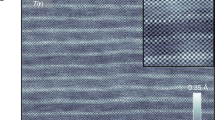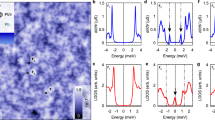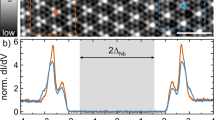Abstract
The nature and behaviour of electronic states in high-temperature superconductors are the centre of much debate. The pseudogap state, observed above the superconducting transition temperature, Tc, is seen by some as a precursor to the superconducting state. Others view it as a competing phase. Recently, this discussion has focused on the number of energy gaps in the system. Some experiments indicate a single energy gap, implying that the pseudogap is a precursor state. Others indicate two, suggesting that it is a competing or coexisting phase. Here, we use temperature-dependent scanning tunnelling spectroscopy of (Bi1−yPby)2Sr2CuO6+x to clarify the situation. We find a previously unobserved narrow and homogeneous gap that vanishes near Tc, superimposed on the typically observed inhomogeneous and broad gap, which is only weakly temperature dependent. These results not only support the two-gap picture, but also explain previously troubling differences between scanning tunnelling microscopy and other experimental measurements.
This is a preview of subscription content, access via your institution
Access options
Subscribe to this journal
Receive 12 print issues and online access
$209.00 per year
only $17.42 per issue
Buy this article
- Purchase on Springer Link
- Instant access to full article PDF
Prices may be subject to local taxes which are calculated during checkout





Similar content being viewed by others
References
Fischer, Ø., Kugler, M., Maggio-Aprile, I., Berthod, C. & Renner, C. Scanning tunneling spectroscopy of high-temperature superconductors. Rev. Mod. Phys. 79, 353–419 (2007).
Renner, C., Revaz, B., Genoud, J. Y., Kadowaki, K. & Fischer, Ø. Pseudogap precursor of the superconducting gap in under- and overdoped Bi2Sr2CaCu2O8+δ . Phys. Rev. Lett. 80, 149–152 (1998).
Kugler, M., Fischer, Ø., Renner, C., Ono, S. & Ando, Y. Scanning tunneling spectroscopy of Bi2Sr2CuO6+δ: New evidence for the common origin of the pseudogap and superconductivity. Phys. Rev. Lett. 86, 4911–4914 (2001).
Kondo, T. et al. Contribution of electronic structure to thermoelectric power in (Bi,Pb)2(Sr,La)2CuO6+δ . Phys. Rev. B 72, 024533 (2005).
Anderson, P. W. The resonating valence bond state in La2CuO4 and superconductivity. Science 235, 1196–1198 (1987).
Geshkenbein, V. B., Ioffe, L. B. & Larkin, A. I. Superconductivity in a system with preformed pairs. Phys. Rev. B 55, 3173–3180 (1997).
Randeria, M., Trivedi, N., Moreo, A. & Scalettar, R. T. Pairing and spin gap in the normal state of short coherence length superconductors. Phys. Rev. Lett. 69, 2001–2004 (1992).
Emery, V. J. & Kivelson, S. A. Importance of phase fluctuations in superconductors with small superfluid density. Nature 374, 434–437 (1995).
Franz, M. & Millis, A. J. Phase fluctuations and spectral properties of underdoped cuprates. Phys. Rev. B 58, 14572–14580 (1998).
Franz, M. & Tesanovic, Z. Algebraic Fermi liquid from phase fluctuations: “Topological” fermions, vortex “Berryons,” and QED3 theory of cuprate superconductors. Phys. Rev. Lett. 87, 257003 (2001).
Anderson, P. W. et al. The physics behind high-temperature superconducting cuprates: The ‘plain vanilla’ version of RVB. J. Phys. Condens. Matter 16, R755–R769 (2004).
Cren, T., Roditchev, D., Sacks, W. & Klein, J. Nanometer scale mapping of the density of states in an inhomogeneous superconductor. Europhys. Lett. 54, 84–90 (2001).
Lang, K. M. et al. Imaging the granular structure of high-Tc superconductivity in underdoped Bi2Sr2CaCu2O8+δ . Nature 415, 412–416 (2002).
Pan, S. H. et al. Microscopic electronic inhomogeneity in the high-Tc superconductor Bi2Sr2CaCu2O8+x . Nature 413, 282–285 (2001).
Howald, C., Fournier, P. & Kapitulnik, A. Inherent inhomogeneities in tunneling spectra of Bi2Sr2CaCu2O8−x crystals in the superconducting state. Phys. Rev. B 64, 100504 (2001).
McElroy, K. et al. Atomic-scale sources and mechanism of nanoscale electronic disorder in Bi2Sr2CaCu2O8+δ . Science 309, 1048–1052 (2005).
Yazdani, A., Howald, C. M., Lutz, C. P., Kapitulnik, A. & Eigler, D. M. Impurity-induced bound excitations on the surface of Bi2Sr2CaCu2O8 . Phys. Rev. Lett. 83, 176–179 (1999).
Hudson, E. W. et al. Interplay of magnetism and high-Tc superconductivity at individual Ni impurity atoms in Bi2Sr2CaCu2O8+δ . Nature 411, 920–924 (2001).
Nunner, T. S., Andersen, B. M., Melikyan, A. & Hirschfeld, P. J. Dopant-modulated pair interaction in cuprate superconductors. Phys. Rev. Lett. 95, 177003 (2005).
Deutscher, G. Coherence and single-particle excitations in the high-temperature superconductors. Nature 397, 410–412 (1999).
Mourachkine, A. Andreev reflections and tunneling spectroscopy on underdoped Nd1.85Ce0.15CuO4−δ . Europhys. Lett. 50, 663–667 (2000).
Wang, Y., Li, L. & Ong, N. P. Nernst effect in high-TC superconductors. Phys. Rev. B 73, 024510 (2006).
Miyakawa, N. et al. Predominantly superconducting origin of large energy gaps in underdoped Bi2Sr2CaCu2O8+δ from tunneling spectroscopy. Phys. Rev. Lett. 83, 1018–1021 (1999).
Loram, J. W., Tallon, J. L. & Liang, W. Y. Absence of gross static inhomogeneity in cuprate superconductors. Phys. Rev. B 69, 060502 (2004).
Mashima, H. et al. Electronic inhomogeneity of heavily overdoped Bi2−xPbxSr2CuOy studied by low-temperature scanning tunneling microscopy/spectroscopy. Phys. Rev. B 73, 060502 (2006).
Zheng, G.-q., Kuhns, P. L., Reyes, A. P., Liang, B. & Lin, C. T. Critical point and the nature of the pseudogap of single-layered copper-oxide Bi2Sr2−xLaxCuO6+δ superconductors. Phys. Rev. Lett. 94, 047006 (2005).
McElroy, K. et al. Coincidence of checkerboard charge order and antinodal state decoherence in strongly underdoped superconducting Bi2Sr2CaCu2O8+δ . Phys. Rev. Lett. 94, 197005 (2005).
Lee, P. A., Nagaosa, N. & Wen, X.-G. Doping a Mott insulator: Physics of high-temperature superconductivity. Rev. Mod. Phys. 78, 17–85 (2006).
Hoffman, J. E. et al. Imaging quasiparticle interference in Bi2Sr2CaCu2O8+δ . Science 297, 1148–1151 (2002).
Tanaka, K. et al. Distinct Fermi-momentum-dependent energy gaps in deeply underdoped Bi2212. Science 314, 1910–1913 (2006).
Kondo, T., Takeuchi, T., Kaminski, A., Tsuda, S. & Shin, S. Evidence for two energy scales in the superconducting state of optimally doped (Bi,Pb)2(Sr,La)2CuO6+d . Phys. Rev. Lett. 98, 267004 (2007).
Le Tacon, M. et al. Two energy scales and two distinct quasiparticle dynamics in the superconducting state of underdoped cuprates. Nature Phys. 2, 537–543 (2006).
Affleck, I. & Marston, J. B. Large-n limit of the Heisenberg–Hubbard model: Implications for high-Tc superconductors. Phys. Rev. B 37, 3774–3777 (1988).
Zaanen, J. & Gunnarsson, O. Charged magnetic domain lines and the magnetism of high-Tc oxides. Phys. Rev. B 40, 7391–7394 (1989).
Kampf, A. P. & Schrieffer, J. R. Spectral function and photoemission spectra in antiferromagnetically correlated metals. Phys. Rev. B 42, 7967–7974 (1990).
Wen, X.-G. & Lee, P. A. Theory of underdoped cuprates. Phys. Rev. Lett. 76, 503–506 (1996).
Chubukov, A. V., Pines, D. & Stojkovic, B. P. Temperature crossovers in cuprates. J. Phys. Condens. Matter 8, 10017–10036 (1996).
Varma, C. M. Non-Fermi-liquid states and pairing instability of a general model of copper oxide metals. Phys. Rev. B 55, 14554–14580 (1997).
Vojta, M. & Sachdev, S. Charge order, superconductivity, and a global phase diagram of doped antiferromagnets. Phys. Rev. Lett. 83, 3916–3919 (1999).
Chakravarty, S., Laughlin, R. B., Morr, D. K. & Nayak, C. Hidden order in the cuprates. Phys. Rev. B 63, 094503 (2001).
Paramekanti, A., Randeria, M. & Trivedi, N. Projected wave functions and high temperature superconductivity. Phys. Rev. Lett. 87, 217002 (2001).
Kivelson, S. A. et al. How to detect fluctuating stripes in the high-temperature superconductors. Rev. Mod. Phys. 75, 1201–1241 (2003).
Kresin, V. Z., Ovchinnikov, Y. N. & Wolf, S. A. Inhomogeneous superconductivity and the “pseudogap” state of novel superconductors. Phys. Rep. 431, 231–259 (2006).
Hoffman, J. A search for alternative electronic order in the high temperature superconductor Bi2Sr2CaCu2O8+x by scanning tunneling microscopy. Dissertation, Univ. California, Berkeley (2003).
Acknowledgements
We thank J. C. Davis, J. E. Hoffman, P. A. Lee, Y. S. Lee, K. McElroy, T. Senthil, Y. Wang and X.-G. Wen for comments. This research was supported in part by a Cottrell Scholarship awarded by the Research Corporation, by the MRSEC program of the NSF under award DMR 02-13282, and also by NSF CAREER award DMR-034891.
Author information
Authors and Affiliations
Contributions
M.C.B., W.D.W. and K.C. shared equal responsibility for all aspects of this project from instrument construction to data collection and analysis. M.Y. conceived the temperature-normalization scheme and carried out much of the data analysis. T.K. grew the samples and helped refine the STM. T.T. and H.I. contributed to sample growth. E.W.H. advised.
Corresponding authors
Rights and permissions
About this article
Cite this article
Boyer, M., Wise, W., Chatterjee, K. et al. Imaging the two gaps of the high-temperature superconductor Bi2Sr2CuO6+x. Nature Phys 3, 802–806 (2007). https://doi.org/10.1038/nphys725
Received:
Accepted:
Published:
Issue Date:
DOI: https://doi.org/10.1038/nphys725
This article is cited by
-
A picture of pseudogap phase related to charge fluxes
npj Computational Materials (2020)
-
Percolative nature of the direct-current paraconductivity in cuprate superconductors
npj Quantum Materials (2018)
-
Emergence of superconductivity in the cuprates via a universal percolation process
Nature Communications (2018)
-
Electronic effect of doped oxygen atoms in Bi2201 superconductors determined by scanning tunneling microscopy
Science China Physics, Mechanics & Astronomy (2018)
-
The study of electronic nematicity in an overdoped (Bi, Pb)2Sr2CuO6+δ superconductor using scanning tunneling spectroscopy
Scientific Reports (2017)



